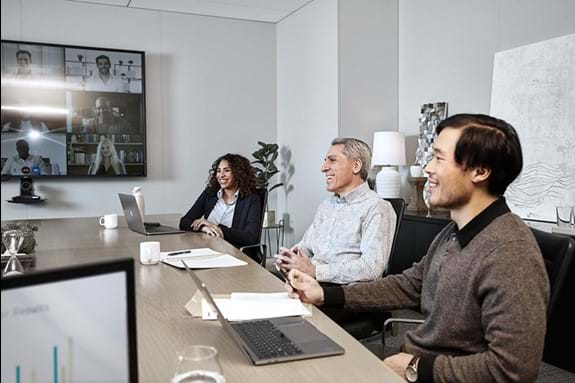See and hear – how to ensure meeting equity in a hybrid world with flawless audio and camera control

With more and more teams heading back to the workplace and students attending lectures in person once again, a new challenge has emerged for IT and AV leaders. They must ensure meeting equity, whereby anyone talking can be heard and seen clearly by all participants, whether they’re still joining remotely from home or back in a physical setting. In large spaces, meeting rooms and classrooms, this can be achieved with the right combination of flawless audio paired with camera control systems.
Are your meetings truly collaborative in today’s hybrid world of work? Can participants joining from home see and be heard? Or is the conversation dominated by those people attending in person? This is what we refer to as ‘meeting equity’ — where everyone has an equal opportunity to contribute, from wherever they are joining a meeting.
It’s a topic that I know will resonate with IT and AV leaders as hybrid work has become the new global norm. In this landscape, we must ensure that our teams have the right collaborative tools to remain as productive as they’ve always been. And these tools include audio technology.
We’re all getting used to the concept of hybrid working as it becomes part and parcel of everyday life. While more and more teams are heading back to the workplace and students are attending lectures in person once again, many others are choosing to continue working from home for at least some of the week. When joining a meeting from home, we’ve become used to seeing our colleagues or fellow students in individual boxes on our screens. Now, in this hybrid work set-up, we might be struggling to see our in-person colleagues or fellow students gathered in a large meeting space.
This presents a new challenge for IT and AV leaders who create and manage these hybrid environments. How do they ensure meeting equity where any talker can be heard and seen clearly by all participants, whether they’re joining remotely from home or in a physical setting?
The ability to see and hear who is talking in a crowded meeting room gives a greater sense of connection. And the greater the connection, the better the employee experience and levels of productivity. In recent research by Frost & Sullivan into how collaboration tools promote active engagement and productivity, 89% of survey respondents said video conferencing helped them feel connected, with 75% saying it increased their productivity.
New ways to unite sound and vision
The meeting equity challenge is being addressed in several ways. One solution for those in the room is Microsoft Teams’ Front Row feature, which “gives participants a greater sense of connection with remote attendees” (quote: Microsoft).
However, for remote attendees joining a boardroom meeting or lecture held in a large classroom, one of the best ways to promote equity for remote attendees is by providing best-in-class audio with a camera control system for the on-premise space.
Why is this combination best? Pairing flexible, premium audio and camera control solutions in a large room allows users to go beyond the capabilities of simple single camera setups designed for just a few participants in cookie-cutter meeting rooms. While these simpler solutions can capture people well in smaller rooms, they struggle in larger spaces where people are sitting spread out, at a distance from the camera, or when there are many people in the same space. For a remote participant to feel the most included in a video conference, a large room needs microphone audio which covers everyone in the room clearly and equally, and an automated camera control system that has the ability to track who is speaking. Clearly seeing and hearing any talker in the meeting is crucial for productive participation.
How does it work?
When someone speaks, information from the microphone(s) is sent to the camera control system telling the controller exactly where in the room the talker is located. This data is then used to quickly and accurately move the camera(s) to precisely frame the talker(s).
Several of Shure’s product ranges, including Microflex® Advance™ and Microflex Complete Wireless, already work seamlessly with a selection of intelligent video solutions including Crestron’s Sightline Solution, and Aver’s PTZ Link software.
The next-generation Shure MXA920 Ceiling Array Microphone provides exact talker coordinates in spaces where not just one, but multiple attendees are speaking, allowing for the most accurate and flexible camera control possibilities. This goes beyond the previous use case of pairing a microphone “lobe” to a single camera preset, bringing better-than-ever performance and enhancing the experience for everyone, including those joining remotely.
The value of meeting equity
The rapid rise of personal videoconferencing and the work-from-home movement have brought new challenges to businesses and educational establishments. Whether in a working or learning environment, people expect to be able to hear and see who’s talking with absolute clarity. This demands parity between those attending in the physical room and those participating remotely to ensure everyone feels connected.
IT and AV leaders now have flexible options to alleviate frustration and promote satisfaction and productivity for every member of a meeting or class. In larger, complex, high-value spaces, it’s essential to combine premium audio with a camera control system to ensure the experience truly delivers for all participants.
Find out more
Want to learn more about the benefits of combining audio with camera control systems?
- Follow the author Richard Knott on LinkedIn
- Read more: https://www.shure.com/en-US/products/microphones/mxa920

About the author
Richard Knott
Richard Knott is Senior Alliances Manager in the Global Technology Partnerships division, working in a cross-functional capacity to bring the latest collaborative solutions to light with Shure’s key technology partners.
Related Posts
ACOUSTICS DEMYSTIFIED
It’s common these days to find meeting spaces that feature the latest audio and video conferencing technology with a view to enabling the best possible meeting experience for users. However, one area that is often overlooked when rooms are being designed and configured is that of room acoustics.
AUDIO BASICS
The role of an IT professional is a varied and changing one. While outsiders may think the focus is on maintaining and installing hardware and software, in reality the scope of the department is much more extensive and it continues to grow.